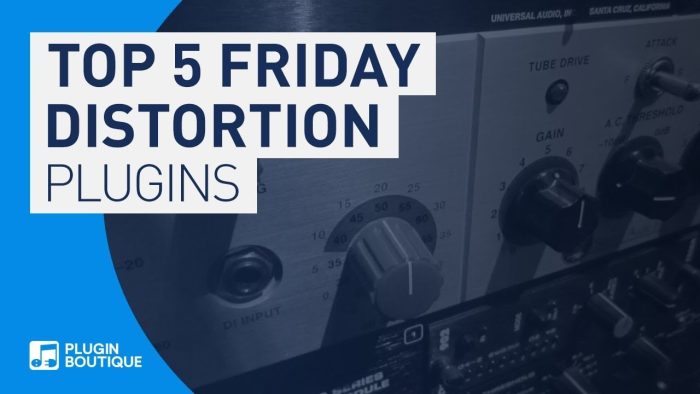In Plugin Boutique’s latest Top 5 Friday episode, Tim Cant takes a look at some popular distortion and saturation effect plugins.
Tim’s top 5 includes:
Step up and maul your sounds using this modulated distortion processor from SoundSpot. Just turn up the Drive to get going, or bring up the Destroy parameter to smash the signal even further.
With six types of modulated distortion, there are plenty of flavours on offer, and you can pan your distortion across the stereo field too.
But where Ravage really gets cool is with its Modulation page. Here, you can create unlimited LFO signals to modulate any parameter you choose. These LFOs aren’t just restricted to certain premade shapes, either – you can draw your own waveform, then reverse it or modulate its pulse width.
This multiband distortion from the iZotope gang is just the ticket for adding flavourful distortion that’s different in the lows and the highs.
Once you’ve set your multiband crossover up, you get to choose two separate stages of overdrive to add to each band. You can choose from pre-existing distortion curves or draw your own. Next, you can apply one of 100 impulse responses in the convolution processor to further enhance the sound of the processing.
As well as that lot, there’s filtering, dynamics, delay and even modulation onboard, making Trash 2 far more than a mere distortion processor, although of course that’s its best feature.
Another multiband effect, Saturn offers up to six bands for you to load one of 16 distortion processors into. Types of processing range from Tube models, through Tape, Amp, Saturation, Rectification and the dastardly Destroy algorithm to turf up your audio – or at least a couple of bands of it.
There’s control over Mix level, Feedback and Dynamics, plus a four-slider output Tone array that works like a graphic EQ. These controls are replicated for each band, allowing you to fully customise the lows, low-mids, upper-mids, or any other band you choose to set up, depending on your material.
Taking it even further, you get FabFilter’s excellent Modulation controls, letting you determine the Drive level of any parameter using LFOs, Envelope Generators, Envelope Followers, XY pads, and MIDI control. All to your Satisfaction?
2. XLN Audio RC-20 Retro Color
Retro Color specializes in a certain type of distortion: the analogue sound of old-school recording and playback technology. The six modules fronting the plugin are all designed to bring an element of retro audio quality to your signal: there’s Noise for adding your choice of crackle or hum, Wobble for the wow and flutter effects of a warped record; Distort for that all-important crunch; Digital for some bitcrushing fun; Space for some delay and reverb effects; and Magnetic to bring out the imperfections of tape-based recording and playback.
The Flux section messes with the parameters under the hood for some unexpected, non-linear results, and there’s filtering Tone, Gain and Width controls to fully customize your signal.
Distortion and Saturation come from the effects of pushing hardware to its limits, and that’s the sort of effect that Decapitator intentionally models. Push up the Drive to get some gentle saturation, flavoursome overdrive or all-out destructive distortion, and engage the Punish knob to smash things up even more.
You actually get five modes of distortion, derived from five piece of hardware. A is a tape machine preamp, E is a channel strip, N is a mixing console, T and P are both modelled after a hardware distortion unit.
Other controls include Tone, which switches the distortion character from Dark to Bright; High and Low Cut filters, an Output control and a Mix control.
All these plugins are available from Plugin Boutique and you can download free trial versions to give them a try.
Although it’s a bit of an older plugin, I really like Ohm Force’s Ohmicide: Melohman. What’s your favorite distortion plugin?
More information: Plugin Boutique


